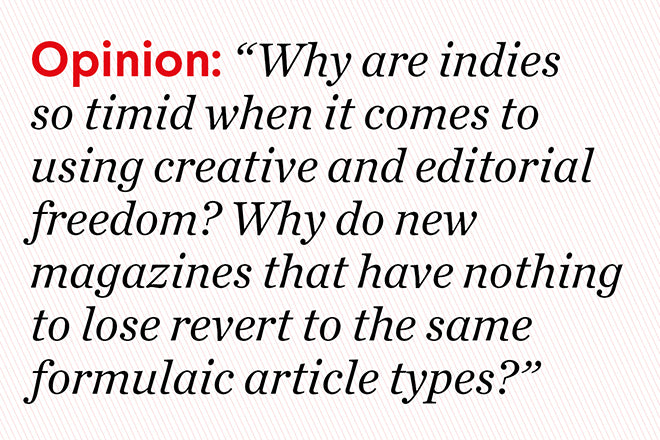
Stop writing safe
In his latest Opinion post, Rob Alderson appeals for more written experimentation alongside the clever designs and physical formats of independent publishing.
I had never heard of the Sunday Correspondent newspaper until I heard Jon Ronson interviewed on the Longform podcast.
Ronson described his professional awakening as reading a piece in the newspaper’s magazine about a professional Andrew Lloyd Webber lookalike who had started to believe he was Andrew Lloyd Webber. “I just thought it was the greatest thing I had ever read; it was funny and surprising and very dialogue heavy,” Ronson explains. Off the back of this recommendation I tracked down the article, written by Luke Jennings, in the British Library. Happily it lived up to expectations. The Sunday Correspondent existed for little more than a year, from September 1989 to November 1990, but in almost every issue of its magazine I found articles like the one that inspired Ronson (many of which were written by him). In trying to do things differently, the magazine gave writers space to tell stories in ways that still feel innovative some quarter of a century later.
From the sleepy fug of the library’s reading rooms to brash new worlds of the South by South West festival in Texas, where I saw the director Chris Milk give a fascinating talk on virtual reality. Milk believes we are at an impasse where we haven’t quite worked out the mechanisms of telling stories using this medium. At the moment we are using it for an enhanced kind of filmmaking, but Milk is certain that, in time, VR will allow the user to be the character rather than just observe the character, in an immersive film/gaming hybrid.
Off the back of Milk’s talk I started thinking about this relationship between different media and the kinds of stories we could or should be telling with them. Flicking through a random selection of magazines from my shelves – about ten titles in total – I found no examples of unusual or experimental article formats beyond the bread-and-butter fare of interviews, essays and reported features. That’s not to say the content itself was bland – from Dirty Furniture and The Happy Reader to The Gentlewoman and The Idler – I came across countless brilliant articles.
But in terms of the how rather than the what, I can’t help but feel we are missing a trick in not exploring less conventional formats. This holds true across the publishing industry, but surely it’s independent magazine makers who are in the best position to mix things up? I am not saying that we have to go as far as David Carson – who famously set an entire interview with Bryan Ferry in Zapf Dingbats – but it would be exciting to see a little more variety.
When I used to oversee Printed Pages, I think we had the confidence and the courage to play around with these ideas only twice. One was my piece on Dan Wieden, which mixed an interview, a lecture and several days’ of observation into a piece of which I was (and am) pretty proud.
The other was a short piece by James Cartwright about private view culture in the art world that merged characteristics of fact and fiction into something that fell between the two. I loved that article but I know that many people hated it (it doesn’t appear to have ever made it online). Still it felt good to try something a bit leftfield, rather than run another Q&A.
I regret that we didn’t do more of this sort of thing. The freedom to experiment is the most exciting thing about making an independent magazine. Whether it’s through fake adverts or enjoyably ridiculous comic strips, I think Mushpit does a great job of toying with traditional formats to create features that confound expectations. But elsewhere I don’t see too many titles having the same kind of fun. Researching this piece, I came across this intriguing article from dot429 for which the straight James Franco interviews the gay James Franco, “to challenge us by challenging himself about preconceived concepts of sexuality and how they fit contextually into his art.” Again whether you love or hate the outcome, you can’t help admire the creative idea.
But why are these kinds of pieces still the exception rather than the rule? Why are indie publishers so timid when it comes to using their creative and editorial freedom? Why do new magazines that have nothing to lose revert to the same four or five formulaic article types? Of course these traditional formats have survived and thrived for a reason – they are easier to grasp, easier to digest, easier to put together. Readers like them. Those being profiled like them. I like them.
But reading Jack Mills’ Wonderland homage to Sleaze Nation, I find myself getting razzed up about a different kind of editorial product, where “Features ranged from the insane, to the pointless, to the unimaginably offensive.” Who wouldn’t want to read an article called “Can you get a horse into a club?”
If the independent magazine sector is going to live up to the vibrancy that we keep patting ourselves on the back for, then surely it’s time for a little more leftfield thinking when it comes to how we tell stories in 2016?


